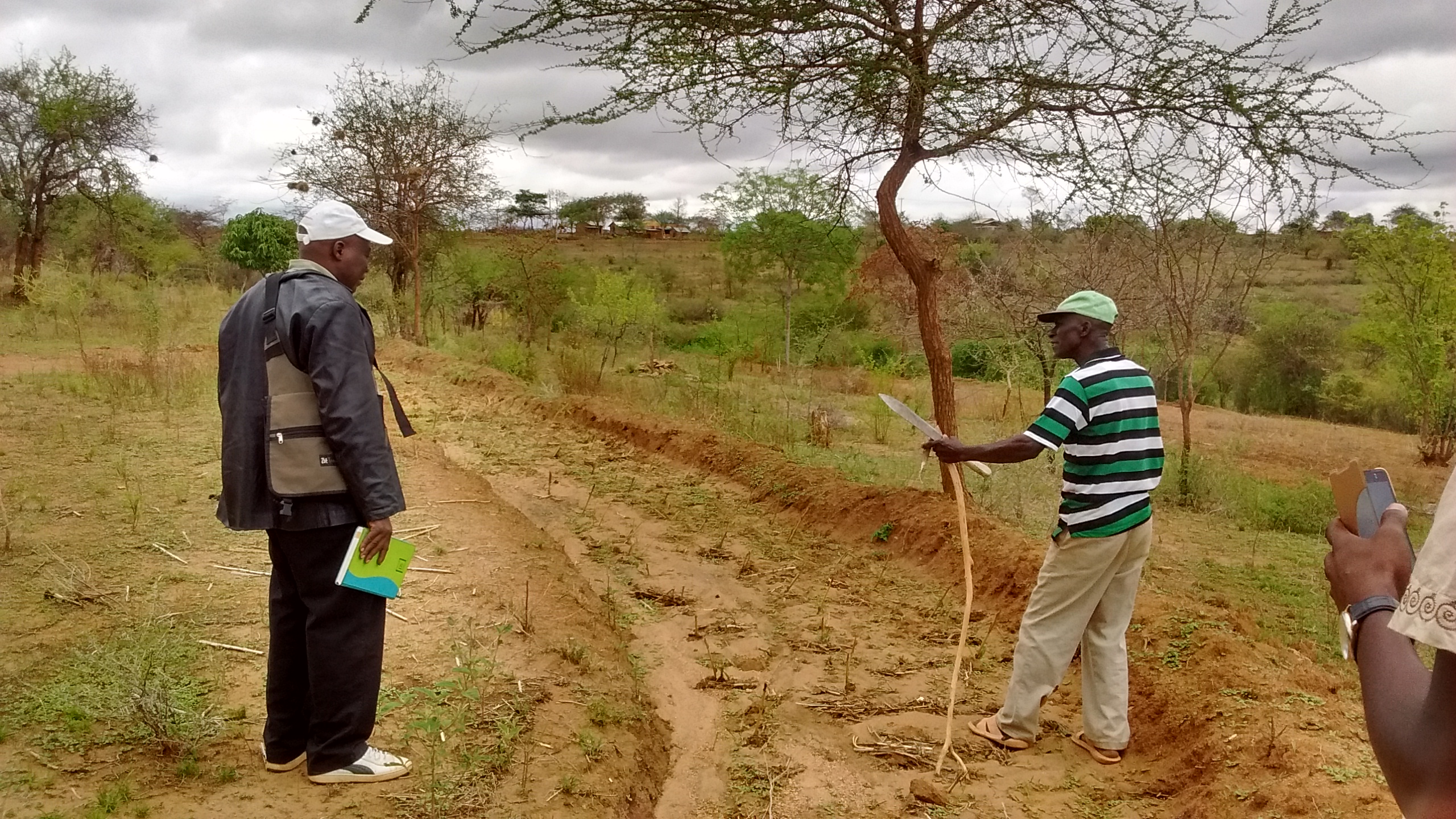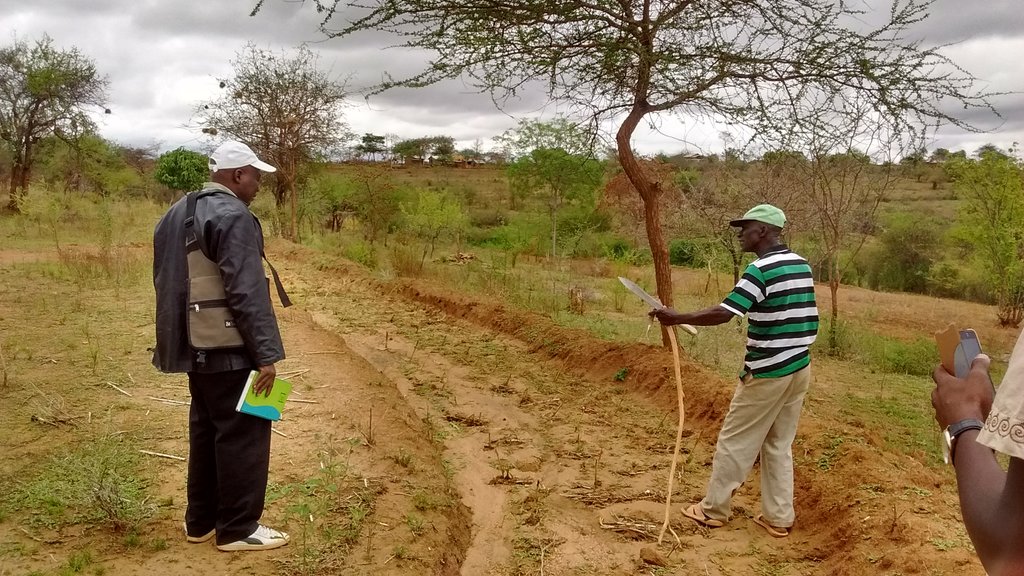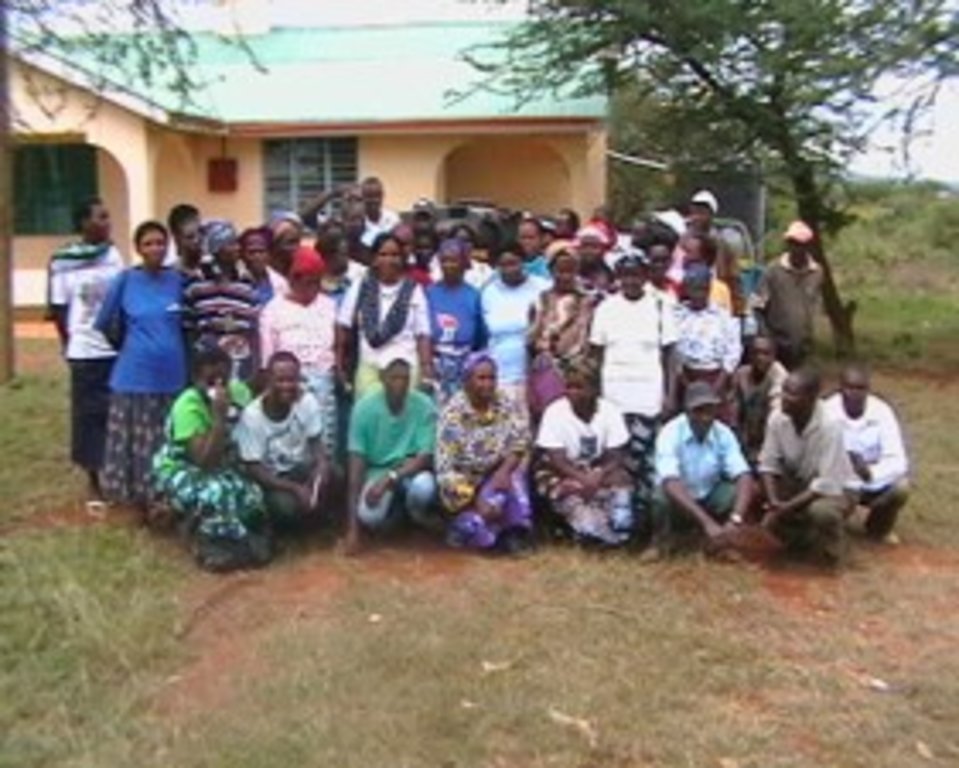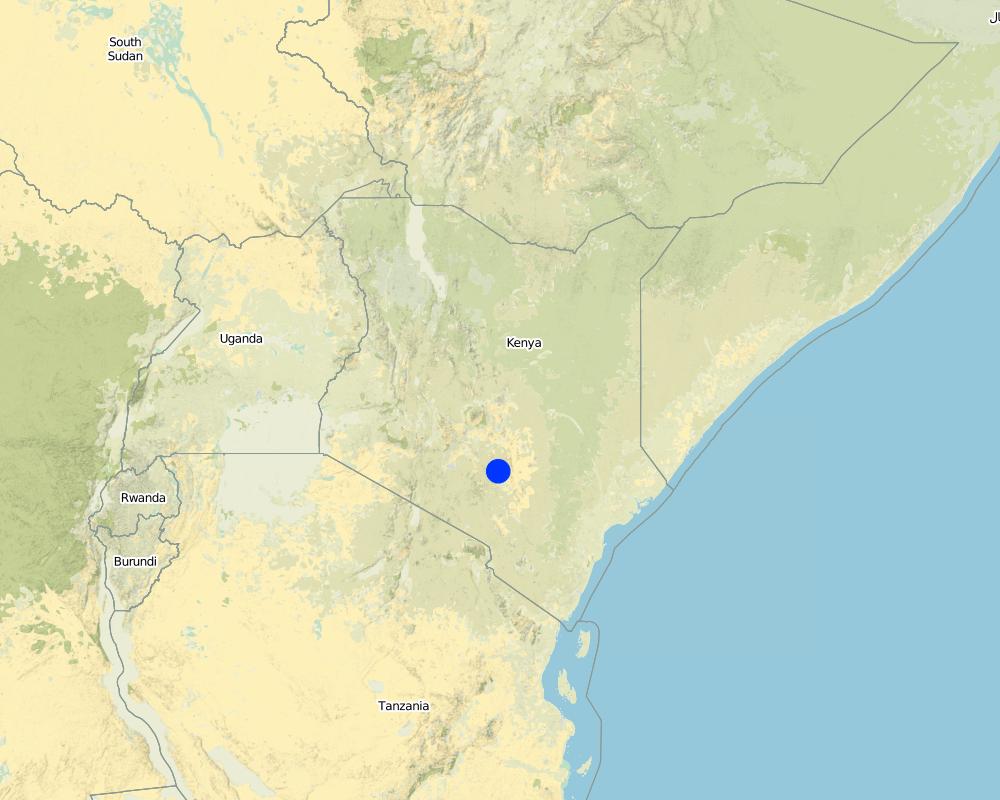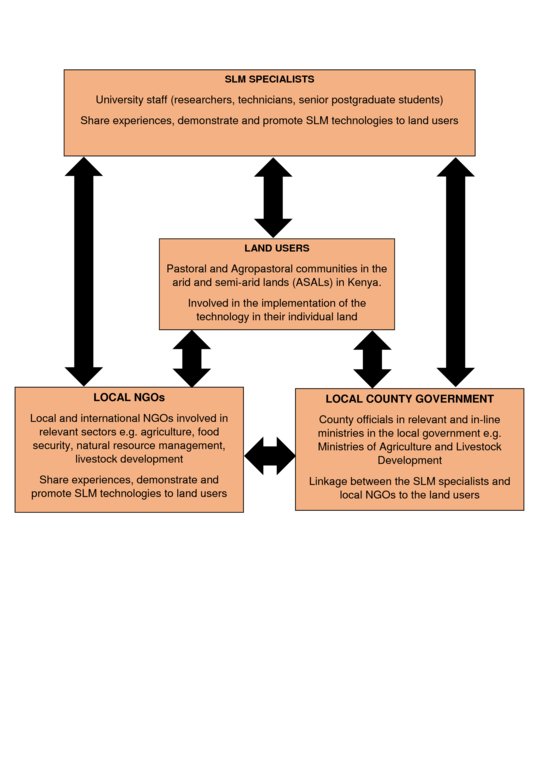In-situ pasture establishment demonstrations [Quênia]
- Criação:
- Atualização:
- Compilador/a: Kevin Mganga
- Editor: –
- Revisor: Rima Mekdaschi Studer
On-farm demos
approaches_3285 - Quênia
- Resumo completo em PDF
- Resumo completo em PDF para impressão
- Resumo completo no navegador
- Resumo completo (sem formatação)
- In-situ pasture establishment demonstrations: 26 de Janeiro de 2018 (inactive)
- On-farm pasture establishment demonstrations : 21 de Fevereiro de 2018 (inactive)
- On-farm indigenous pasture establishment demonstrations : 20 de Abril de 2018 (inactive)
- On-farm indigenous pasture establishment demonstrations : 3 de Setembro de 2018 (public)
Veja as seções
Expandir tudo Recolher tudo1. Informação geral
1.2 Detalhes do contato das pessoas capacitadas e instituições envolvidas na avaliação e documentação da abordagem
Pessoa(s) capacitada(s)
Especialista em GST:
Nome do projeto que facilitou a documentação/avaliação da Abordagem (se relevante)
Book project: Guidelines to Rangeland Management in Sub-Saharan Africa (Rangeland Management)Nome da(s) instituição(ões) que facilitou(ram) a documentação/avaliação da Abordagem (se relevante)
Department of Range and Wildlife Sciences, South Eastern Kenya University (SEKU) - Quênia1.3 Condições em relação ao uso da informação documentada através de WOCAT
Quando os dados foram compilados (no campo)?
10/11/2017
O compilador e a(s) pessoa(s) capacitada(s) aceitam as condições relativas ao uso de dados documentados através do WOCAT:
Sim
1.4 Referência ao(s) questionário(s) sobre tecnologias da GST
2. Descrição da abordagem de GST
2.1 Descrição curta da abordagem
In-situ pasture establishment demonstration programs and initiatives in the arid and semi-arid environments in Kenya. A more practical approach to enable the end-users appreciate the technology for easier adoption in their individual farms.
2.2 Descrição detalhada da abordagem
Descrição detalhada da abordagem:
The main characteristic and distinct feature is the interaction of different stakeholders (land users, NGOs, SLM specialists, local government officials and university researchers) in on-farm showcasing of sustainable land management technologies. Sustainable land management specialists, mostly researchers from the university with the help of local government and NGOs field officers demonstrate the entire process of grass reseeding technology from site selection, seedbed preparation, grass species selection, weeding, monitoring and evaluation (both plant and soil parameters). The main method used was on-farm demonstrations both at individual and pastoral and agropastoral groups sites (local land users sites) and a model demonstration site within the university premises (university site). The main stakeholders involved in the process are the SLM specialists, mainly researchers from the university (to share the knowledge, skills and technology), local government (county officials) (link the SLM specialists with the pastoral communities, share their experiences through on-farm demonstrations and explanations of similar technologies), local NGOs (to share the knowledge, past experiences and skills) and pastoral communities (the end users of the technologies, who also shared their indigenous technical knowledge related to natural resource management). The end-users, approximately 40 livestock keepers during the 5 visits and demonstrations, liked the approach because it was more practical (seeing is believing) i.e. on-farm, and can be easily replicated in individual lands under the same local conditions e.g. climate, soil type, grass species, methods of land preparation, land use system. After interacting with the SLM specialists from the universities during the visits and on-farm demonstrations, land-users have adopted the technology to ensure a continuous supply of pasture for their livestock.
2.3 Fotos da abordagem
Observações gerais sobre as fotos:
Stakeholders discussing and sharing their knowledge and skills
2.5 País/região/locais onde a abordagem foi aplicada
País:
Quênia
Região/Estado/Província:
Eastern Province
Especificação adicional de localização:
Kitui municipality, Kitui county
Map
×2.6 Datas de início e término da abordagem
Caso o ano exato seja desconhecido, indique a data aproximada de início da abordagem:
menos de 10 anos atrás (recentemente)
2.7 Tipo de abordagem
- Iniciativa/inovação local recente
2.8 Principais metas/objetivos da abordagem
Demonstrate indigenous pasture establishment in-situ and encourage land users to practice reseeding as a means of 1) rehabilitating their degraded lands, 2) provide forage for their livestock and 3) income generation through sale of surplus animal products(e.g. milk), hay and seeds.
2.9 Condição que propiciam ou inibem a implementação de tecnologia/tecnologias aplicada(s) segundo a abordagem
Normas e valores sociais/culturais/religiosos
- Propício
Land users are livestock keepers so technologies and approaches to improve livestock production are welcome.
- Inibitivo
Gender based constraints where the male dominate on-farm training/demonstrations compared to female land users
Disponibilidade/acesso a recursos e serviços financeiros
- Propício
Facilitation from previous (Agricultural Innovation for Dryland Africa, AIDA) and on-going research project (Rainwater harvesting for Indigenous Pasture Production, ROFIP, in semi-arid Kitui County, Kenya). The current ROFIP project is under the Food and Business Applied Research Fund (ARF) funded by the he Netherlands Organisation for Scientific Research (NWO)
- Inibitivo
Accessing money/financial resources from government/public institutions and organisation is long (much slower) due to e.g. bureaucracy and protocol, compared to private organisation (much faster access, less bureaucratic)
Quadro institucional
- Propício
University encourages extension service delivery to the local community and supports such initiatives to reach out to land users to share knowledge and expertise.
- Inibitivo
Coordinating different stakeholders both in the private (NGOs) and public sector (university, local government), together with land users is often a challenge mainly due to the different nature of operations e.g. bureaucracy, protocol
Colaboração/coordenção de atores
- Propício
Collaboration between university, local government and local land users
- Inibitivo
Different stakeholders (e.g. land users, university, local government, NGOs) all have different key objectives to achieve within the general aim/objectives. This often hinders the coordination of actors and implementation of the approach.
Quadro jurídico (posse de terra, direitos de uso da terra e da água)
- Propício
Land used in the approach and for demonstrating the reseeding technology are privately owned.
- Inibitivo
Land is owned as private, communal and group. This determines the organisation and arrangement of the approach.
Governança da terra (tomada de decisões, implementação e aplicação)
- Propício
Conhecimento sobre GST, acesso a suporte técnico
- Propício
SLM specialists have knowledge about the SLM technologies and various approaches.
Mercados (para comprar entradas, vender produtos) e preços
- Propício
- Inibitivo
Some of the inputs e.g. indigenous grass seeds, are not available in the formal seed market in Kenya. Reliance on the informal seed market often leads to the purchase and use of uncertified seeds with poor end results.
Carga de trabalho, disponibilidade de força de trabalho
- Propício
Use of local casual labourers. This contributes to owning the project activities and easier implementation in their individual farms.
- Inibitivo
Division of man-hours between the project demonstration sites and individual activities. This may often lead to delays in implementing project activities.
3. Participação e papel das partes interessadas envolvidas
3.1 Partes interessadas envolvidas na abordagem e seus papéis
- Usuários de terra/comunidades locais
local land users and livestock keepers
Share their indigenous technical knowledge; provide land for on-farm demonstrations
- Especialistas em GST/ consultor agrícola
university researchers
Describe the technologies using practical on-farm demonstrations. Additionally, share and present scientific research findings to demonstrate the contribution of the use of the technology for increased indigenous pasture production i.e. evidence based
- Professores/alunos/estudantes
university students
Practical demonstrations
- Organização não governamental
Local NGO (Roads for Water)
Collaborate with university researchers to demonstrate to different land users and managers (e.g. researchers, pastoral and agropastoral communities) how other land management strategies e.g. rainwater harvesting using roads as a catchment can be incorporated in reseeding programs to enhance pasture establishment especially in dryland environments.
- Governo local
Extension agents and advisors in the county government
Link to the end-users, share past experiences and knowledge on SLM approaches
3.2 Envolvimento do usuários de terra/comunidades locais nas diferentes fases da abordagem
| Envolvimento do usuários de terra/comunidades locais | Especifique quem estava envolvido e descreva as atividades | |
|---|---|---|
| Iniciação/motivação | Participativo | Local land users involved in the site selection and involved in the plans of the project. Local land users share their indigenous technical knowledge (ITK) gained through man years of experience on aspects such as; which species are preferred by free grazing animals (i.e. ranking different species); which grass species perform better under different rainfall regimes, topography and soil types; which grass species are best suited for soil conservation and soil erosion control. |
| Planejamento | Participativo | Local land users actively involved in deciding on scheduled land users visits and demonstrations. Local land users participate and contribute to the planning of e.g. sowing dates, methods of land preparation, grass species selection in relation to their individual taste and preference and intended use (fodder for livestock, soil conservation and combating degradation, large scale seed production). |
| Implementação | Participativo | Demonstration conducted on individual 'farms'/ pastures and local land users implement the technologies as 'model land users'. |
| Monitoramento/avaliação | Participativo | Constant communication from through short message services (SMS) and telephone calls on progress and challenges as land users monitor changes e.g. seed germination, seedling establishment. Local land users report this to the SLM specialists e.g. researchers in the university and post-graduate students involved in the projects. |
| Research | Passivo | Research is mainly conducted by SLM specialists at university and students. Local government are also involved in doing research since some of the students recruited to be part of the project e.g PhD and MSc students are permanently employed by the local government. Local land users share their indigenous technical knowledge (ITK) through one-on-one informal discussions/sessions between them and the SLM specialists and students. |
3.3 Fluxograma (se disponível)
Descrição:
Interaction between different stakeholders (SLM specialists, local government, local NGOs and land users) for in-situ pasture establishment demonstrations in arid and semi-arid environments in Kenya
Autor:
Kevin Z. Mganga
3.4 Decisão sobre a seleção de tecnologia/tecnologias de GST
Especifique quem decidiu sobre a seleção de tecnologia/tecnologias a serem implementadas:
- todos os atores relevantes, como parte de uma abordagem participativa
Especifique em que base foram tomadas as decisões:
- Avaliação de conhecimento bem documentado de GST (tomada de decisão baseada em evidências)
- Resultados de pesquisa
- Experiência pessoal e opiniões (não documentado)
4. Suporte técnico, reforço das capacidades e gestão do conhecimento
4.1 Reforço das capacidades/formação
Foi oferecida formação aos usuários da terra/outras partes interessadas?
Sim
Especifique quem foi capacitado:
- Usuários de terra
- Equipe de campo/consultores
Caso seja relevante, especifique gênero, idade, status, etnia, etc.
The land users and field staff/advisers were drawn from both genders (male and female). University undergraduate students (both male and female students, between the ages of 20-24 years) were also involved in the training during on-farm practical sessions.
Tipo de formação:
- Áreas de demonstração
Assuntos abordados:
site selection, seedbed preparation, choice of grass species, monitoring and evaluation (plant and soil attributes), maintenance and further management
4.2 Serviço de consultoria
Os usuários de terra têm acesso a um serviço de consultoria?
Sim
Especifique se foi oferecido serviço de consultoria:
- nas áreas dos usuários da terra
Descreva/comentários:
Advisory services on-farm during visits
4.3 Fortalecimento da instituição (desenvolvimento organizacional)
As instituições foram fortalecidas ou estabelecidas através da abordagem?
- Sim, moderadamente
Especifique a que nível (níveis) as instituições foram fortalecidas ou estabelecidas:
- Local
- Regional
- Nacional
Descreva instituição, papéis e responsabilidades, membros, etc.
University (South Eastern Kenya University, SEKU) - extension and outreach and research and academic exchange programs with other research institutions e.g. Kenya Agricultural and Livestock Research Organization (KALRO), International Crops Research Institute for the Semi-Arid Tropics (ICRISAT), Kenya Seed Company, and other universities e.g. University of Nairobi (UoN)
Especifique o tipo de apoio:
- Financeiro
- Reforço das capacidades/formação
Dê mais detalhes:
Financial support from within university research funds and the National Research Fund (NRF), Kenya, through the Ministry of Education, Science and Technology. Capacity building through postgraduate training involving researchers from SEKU, KALRO, ICRISAT and UoN
4.4 Monitoramento e avaliação
Monitoramento e avaliação são partes da abordagem?
Sim
Comentários:
Adoption and uptake of the technologies among land users
Caso afirmativo, esta documentação é destinada a ser utilizada para monitoramento e avaliação?
Sim
Comentários:
The approach demonstrates sustainable land management technologies e.g. grass reseeding, on farm. This is aimed at increasing adoption and spread of the technology by other land users.
4.5 Pesquisa
A pesquisa foi parte da abordagem?
Sim
Especifique os tópicos:
- Ecologia
- Tecnologia
Dê mais detalhes e indique quem realizou a pesquisa:
Part of a SLM specialist i.e. researcher at the university, research project
5. Financiamento e apoio material externo
5.1 Orçamento anual para o componente de GST da abordagem
Caso o orçamento exato seja desconhecido, indique a faixa:
- 2.000-10.000
Comentários (p. ex. principais fontes de recursos/principais doadores):
Food and Business Applied Research Fund (ARF) funded by the The Netherlands Organisation for Scientific Research (NWO), Netherlands
5.2 Apoio financeiro/material concedido aos usuários da terra
Os usuários da terra receberam apoio financeiro/material para a implementação de tecnologia/tecnologias?
Sim
Caso afirmativo, especifique tipo(s) de apoio, condições e fornecedor(es):
Land and seed bed preparation: hiring of casual labour and rent of machinery/equipment (ox-plough/tractor)
5.3 Subsídios para entradas específicas (incluindo mão-de-obra)
- Mão-de-obra
| Em que medida | Especifique os subsídios |
|---|---|
| Parcialmente financiado | In cash subsidy mainly for land/site preparation e.g. creating of micro-catchments using ox-driven ploughs, digging trenches as structures for rainwater harvesting. |
- Equipamento
| Especifique quais entradas foram subsidiadas | Em que medida | Especifique os subsídios |
|---|---|---|
| Maquinário | Totalmente financiado | Ox-driven ploughs for site preparation. Occasionally tractors |
| Ferramentas | Totalmente financiado | Hand held hoes for bush clearing and site preparation |
- Agrícola
| Especifique quais entradas foram subsidiadas | Em que medida | Especifique os subsídios |
|---|---|---|
| Sementes | Totalmente financiado | Indigenous grass seeds used in the technology and approach are provided for by the project. However, seed for subsequent sowing is expected to be harvested from the established pasture sites |
Se a mão-de-obra pelos usuários da terra foi uma entrada substancial, isso foi:
- Voluntário
Comentários:
This is mainly for maintaining, monitoring and evaluation of the on-farm sites e.g. aspects of maintaining the fence to keep of free-ranging livestock from damaging the established pastures and assisting other hired labourers e.g. in seeding.
5.4 Crédito
Foi concedido crédito segundo a abordagem para atividades de GST?
Não
5.5 Outros incentivos ou instrumentos
Foram utilizados outros incentivos ou instrumentos para promover a implementação das tecnologias de GST?
Não
6. Análise de impactos e declarações finais
6.1 Impactos da abordagem
A abordagem concedeu autonomia aos usuários locais de terra, melhorou a participação das partes interessadas?
- Não
- Sim, pouco
- Sim, moderadamente
- Sim, significativamente
They owned and embraced the initiative since it involved them from the onset
A abordagem propiciou a tomada de decisão baseada em evidências?
- Não
- Sim, pouco
- Sim, moderadamente
- Sim, significativamente
On-farm sites are used for both demonstrations and experimental plots for research. This is mainly conducted by SLM specialists from the university and postgraduate students in close collaboration with land users (e.g. farmers) aimed at comparing different treatments for the technologies.
A abordagem auxiliou os usuários da terra a implementar e manter as tecnologias de GST?
- Não
- Sim, pouco
- Sim, moderadamente
- Sim, significativamente
Practical on-farm demonstrations in their individual farms
A abordagem melhorou a coordenação e a implementação economicamente eficiente da GST?
- Não
- Sim, pouco
- Sim, moderadamente
- Sim, significativamente
Communication through SMS and phone calls, exchange of photos/videos of demonstrations through WhatsApp groups and emails
A abordagem mobilizou/melhorou o acesso aos recursos financeiros para implementação da GST?
- Não
- Sim, pouco
- Sim, moderadamente
- Sim, significativamente
Joint research grants and funds through collaborative work among stakeholders mostly between local NGOs and universities
A abordagem aprimorou o conhecimento e as capacidades dos usuários da terra para implementar a GST?
- Não
- Sim, pouco
- Sim, moderadamente
- Sim, significativamente
Through practical and hands-on on-farm demonstrations by SLM specialists
A abordagem aprimorou o conhecimento e as capacidades de outras partes interessadas?
- Não
- Sim, pouco
- Sim, moderadamente
- Sim, significativamente
Local government and NGOs appreciating the technologies and serve as ambassadors of the same
A abordagem construiu/fortaleceu instituições, colaboração entre partes interessadas?
- Não
- Sim, pouco
- Sim, moderadamente
- Sim, significativamente
Collaboration between universities, local government, local NGOs and land users strenghtened
A abordagem atenuou conflitos?
- Não
- Sim, pouco
- Sim, moderadamente
- Sim, significativamente
A abordagem concedeu autonomia aos grupos social e economicamente desfavorecidos?
- Não
- Sim, pouco
- Sim, moderadamente
- Sim, significativamente
A abordagem melhorou a igualdade de gêneros e concedeu autonomia a mulheres e meninas?
- Não
- Sim, pouco
- Sim, moderadamente
- Sim, significativamente
Female land users involved
A abordagem encorajou os jovens/as próximas gerações de usuários de terra a se envolverem na GST?
- Não
- Sim, pouco
- Sim, moderadamente
- Sim, significativamente
Young farmers involved. Also students in universities as part of practicals.
A abordagem resultou em segurança alimentar aprimorada/nutrição melhorada?
- Não
- Sim, pouco
- Sim, moderadamente
- Sim, significativamente
Improved pasture production for livestock, healthy animals
A abordagem melhorou o acesso aos mercados?
- Não
- Sim, pouco
- Sim, moderadamente
- Sim, significativamente
Market for sale of grass seeds
A abordagem aprimorou a capacidade dos usuários da terra de adaptar-se a mudanças climáticas/extremos e atenuar os desastres relacionados com o clima?
- Não
- Sim, pouco
- Sim, moderadamente
- Sim, significativamente
Combining the use of indigenous drought tolerant grass species and water harvesting
A abordagem resultou em emprego, oportunidades de renda?
- Não
- Sim, pouco
- Sim, moderadamente
- Sim, significativamente
Through sale of grass seeds and hay, surplus animal products (mostly milk) in seasons of plenty.
6.2 Principal motivação dos usuários da terra para implementar a GST
- Produção aumentada
Increased pasture yields (improved livestock production)
- Lucro (lucrabilidade) aumentado, melhora da relação custo-benefício
Sale of grass seeds and hay and surplus animal products e.g. milk and healthy animals at a good market price
- Degradação do solo reduzida
Established pastureland reduces soil erosion and contributes to enhanced soil moisture and C-sequestration (soil ecosystem services).
- Consciência ambiental
Environmental conservation
6.3 Atividades de sustentabilidade de abordagem
Os usuários da terra podem manter o que foi implementado através da abordagem (sem apoio externo)?
- Sim
Caso afirmativo, descreva como:
Approach is practical and involves the use of already existing knowledge and skills e.g. use of ox-plough for site preparation (creating micro-catchments) is not foreign; local land users have interacted with the indigenous grasses
6.4 Pontos fortes/vantagens da abordagem
| Pontos fortes/vantagens/oportunidades na visão do usuário da terra |
|---|
| Ease to understand and appreciate because of its practical nature |
| Approach allows a close interaction and exchange between the different stakeholders (land users, NGOs, local government officials, SLM specialists, universities) i.e. provides a link between science-practice link, learning by doing. |
| Pontos fortes/vantagens/oportunidades na visão do compilador ou de outra pessoa capacitada |
|---|
| On-farm and practical approach for easy adoption by other land users |
| Takes advantage of group dynamics where different stakeholders share and provide immediate feedback and seek clarification throughout the process thus enriching the discussions |
6.5 Pontos fracos, desvantagens da tecnologia e formas de superá-los
| Pontos fracos/desvantagens/riscos na visão do usuário da terra | Como eles podem ser superados? |
|---|---|
| Source of conflict between land user where the on-farm demonstration has been conducted and other neighboring land users e.g. diverting run-off in the upland thus reducing the volume of rainwater reaching farms located down-slope. | Continuous capacity building, knowledge sharing and sensitization |
| Choice of on-farm demonstration site at an individual land owner can lead to aggravation among other land users | Use of communal or group owned land for on-farm demonstrations |
| Allocation of time to attend the on-farm demonstrations. The approach is often conducted before the onset of the rains, when the land-users are busy preparing their own farms for sowing. This might lead to low turn-outs during demonstrations. | In consultation with the land users, set the date(s) when majority of the land users are available. |
| Pontos fracos/vantagens/riscos na visão do compilador ou de outra pessoa capacitada | Como eles podem ser superados? |
|---|---|
| Language barrier (SLM specialists and land users) | Involving a local land user/personnel to bridge the gap |
7. Referências e links
7.1 Métodos/fontes de informação
- visitas de campo, pesquisas de campo
20
- entrevistas com usuários de terras
50
7.2 Referências às publicações disponíveis
Título, autor, ano, ISBN:
KZ Mganga, NKR Musimba, DM Nyariki. 2015. Competition indices of three perennial grasses used to rehabilitate degraded semi-arid rangelands in Kenya. The Rangelands Journal 37: 489-495
Disponível de onde? Custos?
The Rangeland Journal, USD 25
Título, autor, ano, ISBN:
KZ Mganga, NKR Musimba, DM Nyariki. 2015. Combining sustainable land management technologies to combat land degradation and improve rural livelihoods in semi-arid lands in Kenya. Environmental Management 56: 1538-1548
Disponível de onde? Custos?
Environmental Management, USD 38
Título, autor, ano, ISBN:
KZ Mganga, NKR Musimba, MM Nyangito, DM Nyariki, AW Mwang’ombe. 2015. The choice of grass species to combat desertification in semi-arid Kenyan rangelands is greatly influenced by their forage value for livestock. Grass and Forage Science 70: 161-167.
Disponível de onde? Custos?
Grass and Forage Science, USD 38
7.3 Links para informação relevante que está disponível online
Título/ descrição:
Competition indices of three perennial grasses used to rehabilitate degraded semi-arid rangelands in Kenya
URL:
http://www.publish.csiro.au/rj/RJ15023
Título/ descrição:
Combining sustainable land management technologies to combat land degradation and improve rural livelihoods in semi-arid lands in Kenya
URL:
https://link.springer.com/article/10.1007/s00267-015-0579-9
Título/ descrição:
The choice of grass species to combat desertication in semi-arid Kenyan rangelands is greatly inuenced by their forage value for livestock
URL:
http://onlinelibrary.wiley.com/doi/10.1111/gfs.12089/abstract
Links e módulos
Expandir tudo Recolher tudoLinks
Não há links
Módulos
Não há módulos


